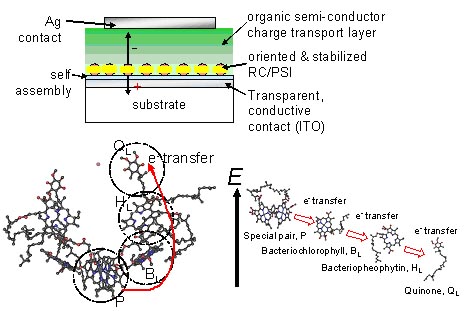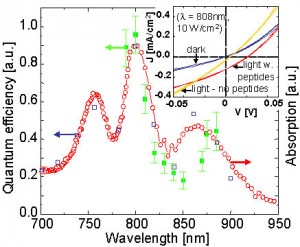Research
Solid State Integration of Photosynthetic Protein Molecular Complexes
J.K. Mapel, M. Singh, M. Segal, M.A. Baldo
Sponsorship: DARPA/AFOSR F49620-02-1-0399, National Science Foundation NIRT
Collaborators: Nikolai Lebedev, Naval Research Labs; Barry Bruce, University of Tennessee, Knoxville; Shuguang Zhang, Massachusetts Institute of Technology
Over two billion years of evolutionary adaptation have optimized the functionality of biological photosynthetic complexes. Plants and photosynthetic bacteria, for example, contain protein molecular complexes that harvest photons with nearly optimum quantum yield and an expected power conversion efficiency exceeding 20%.
We have demonstrated the solid state integration of photosynthetic complexes. The functionality of the complexes is tested by fabricating solid state photodetectors and photovoltaic devices, using complexes isolated from spinach leaves or photosynthetic bacteria. The internal quantum efficiency of the first generation of devices is estimated to be 12%.
Stabilizing the complexes in an artificial environment is the key barrier to successful device integration. We achieved electronic integration of devices (see Fig. 1) by stabilizing an oriented, self-assembled monolayer of photosynthetic complexes using novel surfactant peptides, and then depositing an organic semiconducting protective coating, required as a buffer to prevent damage to the complexes when depositing the top metal contact. Successful integration is conclusively demonstrated by comparisons of the absorption spectrum and photocurrent spectra in Fig. 2.
Fig. 1 (top left) The structure of solid-state devices incorporating photosynthetic complexes. (bottom left) The internal molecular circuitry of a photosynthetic bacterial reaction center with the protein scaffold removed for clarity. The complex is only a few nanometers top-to-bottom. After photoexcitation, an electron is transferred from the special pair, P, to the quinone, QL. The process occurs within 200ps, at nearly 100% quantum efficiency, and results in a 0.5V potential across the complex.
Fig. 2 The photocurrent spectrum of solid-state photovoltaic devices employing bacterial reaction centers (RCs). A comparison between the photocurrent spectrum of solid-state (¦) and wet electrochemical cell devices (?), and the solution absorption spectrum of the bacterial reaction centers (–o–), demonstrates that the observed photocurrent originates in the RCs. Inset: stabilization of RC complexes with A6K/V6D peptides improves the internal quantum efficiency of the devices to 12% under short circuit conditions.
While initial results demonstrate the functionality of biological materials in solid state devices, photovoltaic performance is limited due to low light absorption; monolayers of photosynthetic structures absorb < 1% of incident light, leading to low overall power efficiencies.
Relevant publications
- R. Das, P.J. Kiley, M. Segal, J. Norville, A.A. Yu, L. Wang, S. Trammell, L.E. Reddick, R. Kumar, S. Zhang, F. Stellacci, N. Lebedev, J. Schnur, B.D. Bruce and M.A. Baldo. ‘Solid State Integration of Photosynthetic Protein Molecular Complexes.’ Nano Letters. 4. 1079-1083 (2004).



